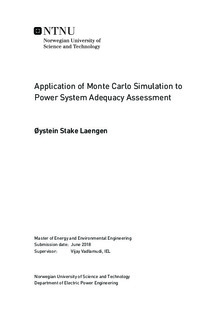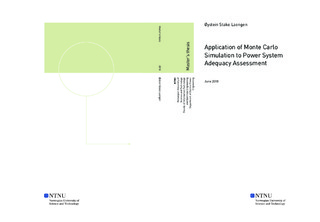| dc.description.abstract | This thesis examines three Monte Carlo Simulation methods that can be used in power system reliability studies. Through application of the methods to both generation- and composite system adequacy assessment, an understanding of the methods was built. The field of probabilistic methods in power system reliability studies is a highly developed field with a lot of written material. However, it can be difficult for an inexperienced reader in the field to understand the small, but important, steps along the path for building Monte Carlo Simulation based applications for generation- and composite system adequacy assessment. Thus, the motivation for this thesis has been to present a transparent and detailed methodology for both levels of adequacy assessment.
The thesis elaborates on the details of obtaining power system adequacy indices through three fundamental Monte Carlo Simulation methods: state sampling, state duration and state transition methods. All the three simulation methods are applied to generation system adequacy assessment, while only the state sampling and the state transition methods are applied to composite system adequacy assessment. A detailed methodology on how to create a DC based contingency solver and an AC based contingency solver for composite system state evaluation, is also proposed in the thesis. The developed scripts created by implementation of the proposed methodology are tested on two test systems (Roy Billinton Test System and IEEE-Reliability Test System). Comparisons of three adequacy indices, viz. loss of load expectation, expected energy not served and loss of load frequency, are made against corresponding benchmark results from literature.
It was observed that the state sampling method provides estimates with a higher precision than the two sequential methods when equal sample sizes are used. The state sampling method, however, is unable to provide distributions of the indices. It was also observed that the state transition method requires less computation time than the two other methods to simulate a year.
A dependency for the bus indices on choice of load curtailment philosophy was observed in the study. The Roy Billinton Test System is found to be more reliable than the IEEE-Reliability Test System. It was also observed that the estimates of the latter s indices are more influenced by the choice of DC based or AC based system representation. | |

